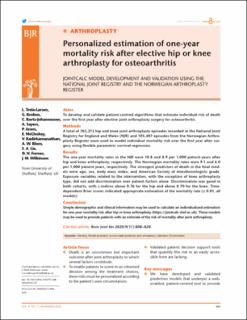| dc.contributor.author | Trela-Larsen, L | |
| dc.contributor.author | Kroken, Gard | |
| dc.contributor.author | Bartz-Johannessen, Christoffer | |
| dc.contributor.author | Sayers, Adele | |
| dc.contributor.author | Aram, P | |
| dc.contributor.author | McCloskey, Eugene | |
| dc.contributor.author | Kadirkamanathan, V | |
| dc.contributor.author | Blom, A | |
| dc.contributor.author | Lie, Stein Atle | |
| dc.contributor.author | Furnes, Ove | |
| dc.contributor.author | Wilkinson, J. Mark | |
| dc.date.accessioned | 2021-05-28T08:38:27Z | |
| dc.date.available | 2021-05-28T08:38:27Z | |
| dc.date.created | 2020-12-16T14:05:40Z | |
| dc.date.issued | 2020 | |
| dc.Published | Bone and Joint Research. 2020, 808-820. | |
| dc.identifier.issn | 2046-3758 | |
| dc.identifier.uri | https://hdl.handle.net/11250/2756802 | |
| dc.description.abstract | Aims
To develop and validate patient-centred algorithms that estimate individual risk of death over the first year after elective joint arthroplasty surgery for osteoarthritis.
Methods
A total of 763,213 hip and knee joint arthroplasty episodes recorded in the National Joint Registry for England and Wales (NJR) and 105,407 episodes from the Norwegian Arthroplasty Register were used to model individual mortality risk over the first year after surgery using flexible parametric survival regression.
Results
The one-year mortality rates in the NJR were 10.8 and 8.9 per 1,000 patient-years after hip and knee arthroplasty, respectively. The Norwegian mortality rates were 9.1 and 6.0 per 1,000 patient-years, respectively. The strongest predictors of death in the final models were age, sex, body mass index, and American Society of Anesthesiologists grade. Exposure variables related to the intervention, with the exception of knee arthroplasty type, did not add discrimination over patient factors alone. Discrimination was good in both cohorts, with c-indices above 0.76 for the hip and above 0.70 for the knee. Time-dependent Brier scores indicated appropriate estimation of the mortality rate (≤ 0.01, all models).
Conclusion
Simple demographic and clinical information may be used to calculate an individualized estimation for one-year mortality risk after hip or knee arthroplasty (https://jointcalc.shef.ac.uk). These models may be used to provide patients with an estimate of the risk of mortality after joint arthroplasty. | en_US |
| dc.language.iso | eng | en_US |
| dc.publisher | Bone and Joint Publishing | en_US |
| dc.rights | Attribution-NonCommercial-NoDerivatives 4.0 Internasjonal | * |
| dc.rights.uri | http://creativecommons.org/licenses/by-nc-nd/4.0/deed.no | * |
| dc.title | Personalized estimation of one-year mortality risk after elective hip or knee arthroplasty for osteoarthritis. | en_US |
| dc.type | Journal article | en_US |
| dc.type | Peer reviewed | en_US |
| dc.description.version | publishedVersion | en_US |
| dc.rights.holder | Copyright 2020 The Authors | en_US |
| cristin.ispublished | true | |
| cristin.fulltext | original | |
| cristin.qualitycode | 1 | |
| dc.identifier.doi | 10.1302/2046-3758.911.BJR-2020-0343.R1 | |
| dc.identifier.cristin | 1860579 | |
| dc.source.journal | Bone and Joint Research | en_US |
| dc.source.pagenumber | 808-820 | en_US |
| dc.identifier.citation | Bone and Joint Research. 2020, 9(11), 808–820 | en_US |
| dc.source.volume | 9 | en_US |
| dc.source.issue | 11 | en_US |

